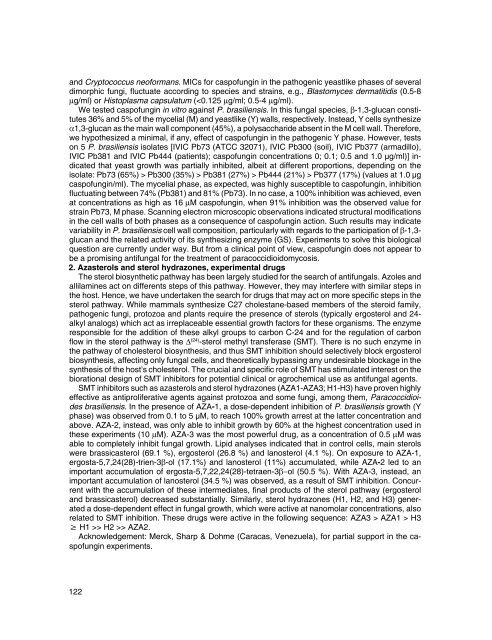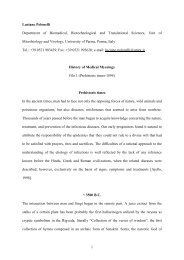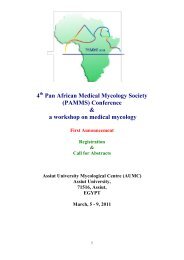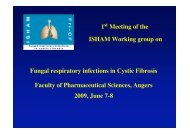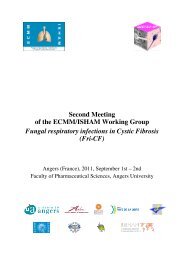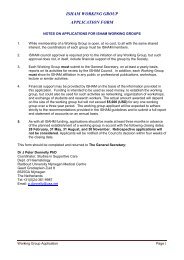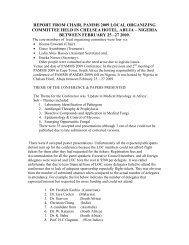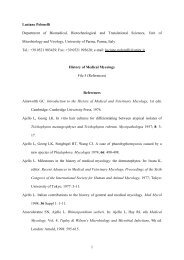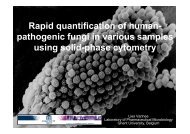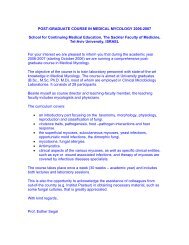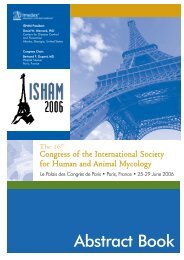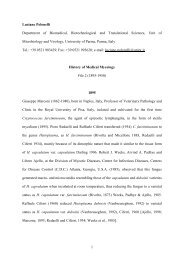and Cryptococcus neoformans. MICs for caspofungin in the pathogenic yeastlike phases of severaldimorphic fungi, fluctuate according to species and strains, e.g., Blastomyces dermatitidis (0.5-8µg/ml) or Histoplasma capsulatum ( Pb300 (35%) > Pb381 (27%) > Pb444 (21%) > Pb377 (17%) (values at 1.0 µgcaspofungin/ml). The mycelial phase, as expected, was highly susceptible to caspofungin, inhibitionfluctuating between 74% (Pb381) and 81% (Pb73). In no case, a 100% inhibition was achieved, evenat concentrations as high as 16 µM caspofungin, when 91% inhibition was the observed value forstrain Pb73, M phase. Scanning electron microscopic observations indicated structural modificationsin the cell walls of both phases as a consequence of caspofungin action. Such results may indicatevariability in P. brasiliensis cell wall composition, particularly with regards to the participation of β-1,3-glucan and the related activity of its synthesizing enzyme (GS). Experiments to solve this biologicalquestion are currently under way. But from a clinical point of view, caspofungin does not appear tobe a promising antifungal for the treatment of paracoccidioidomycosis.2. Azasterols and sterol hydrazones, experimental drugsThe sterol biosynthetic pathway has been largely studied for the search of antifungals. Azoles andallilamines act on differents steps of this pathway. However, they may interfere with similar steps inthe host. Hence, we have undertaken the search for drugs that may act on more specific steps in thesterol pathway. While mammals synthesize C27 cholestane-based members of the steroid family,pathogenic fungi, protozoa and plants require the presence of sterols (typically ergosterol and 24-alkyl analogs) which act as irreplaceable essential growth factors for these organisms. The enzymeresponsible for the addition of these alkyl groups to carbon C-24 and for the regulation of carbonflow in the sterol pathway is the ∆ (24) -sterol methyl transferase (SMT). There is no such enzyme inthe pathway of cholesterol biosynthesis, and thus SMT inhibition should selectively block ergosterolbiosynthesis, affecting only fungal cells, and theoretically bypassing any undesirable blockage in thesynthesis of the host’s cholesterol. The crucial and specific role of SMT has stimulated interest on thebiorational design of SMT inhibitors for potential clinical or agrochemical use as antifungal agents.SMT inhibitors such as azasterols and sterol hydrazones (AZA1-AZA3; H1-H3) have proven highlyeffective as antiproliferative agents against protozoa and some fungi, among them, Paracoccidioidesbrasiliensis. In the presence of AZA-1, a dose-dependent inhibition of P. brasiliensis growth (Yphase) was observed from 0.1 to 5 µM, to reach 100% growth arrest at the latter concentration andabove. AZA-2, instead, was only able to inhibit growth by 60% at the highest concentration used inthese experiments (10 µM). AZA-3 was the most powerful drug, as a concentration of 0.5 µM wasable to completely inhibit fungal growth. Lipid analyses indicated that in control cells, main sterolswere brassicasterol (69.1 %), ergosterol (26.8 %) and lanosterol (4.1 %). On exposure to AZA-1,ergosta-5,7,24(28)-trien-3β-ol (17.1%) and lanosterol (11%) accumulated, while AZA-2 led to animportant accumulation of ergosta-5,7,22,24(28)-tetraen-3β−ol (50.5 %). With AZA-3, instead, animportant accumulation of lanosterol (34.5 %) was observed, as a result of SMT inhibition. Concurrentwith the accumulation of these intermediates, final products of the sterol pathway (ergosteroland brassicasterol) decreased substantially. Similarly, sterol hydrazones (H1, H2, and H3) generateda dose-dependent effect in fungal growth, which were active at nanomolar concentrations, alsorelated to SMT inhibition. These drugs were active in the following sequence: AZA3 > AZA1 > H3≥ H1 >> H2 >> AZA2.Acknowledgement: Merck, Sharp & Dohme (Caracas, Venezuela), for partial support in the caspofunginexperiments.122
Nanobiotechnology: Advances in antifungal therapyA.C. Amaral 1, 2 and Felipe M.S. 11Instituto de Ciências Biológicas, Universidade de Brasília, UnB, Brasília, Brazil2Ciências Genômicas e Biotecnologia, Universidade Católica de Brasília, UCB, Brasília, Brazile-mail: amaralandre@yahoo.com.brNanotechnology presents enormous potential to prepare new antifungal drugs. This science worksat 10 -9 part of a meter; in this scale it is possible to design a drug-delivery system to drive the drug tothe infection site or to maintain drug levels at a therapeutic concentration over long periods of time(Nat. Rev. Cancer, 6:688-701). Although AMB is a potent drug to combat pathogens, its use is limitedby severe adverse side effects as fever, anorexia and nephrotoxicity. Lipid-based nanopreparationscontaining AMB represent a promise to minimize the adverse side effects caused by this drug, andthree of these formulations are commercially available for clinical use: Abelcet ® , Amphotec ® , andAmbisome ® . These lipid preparations reduce the nephrotoxicity by its link to plasmatic proteins andcan be safely used in patients with various conditions predisposing to renal impairment (Int. J. Antimicrob.Agents, 27S:S12-S16, 2006). Even improving the therapeutic index of AMB, some drawbacksstill remain, as for example, all of these formulations lack the ability to release AMB at controlledrates and, accordingly, it has to be daily administered. Polymeric controlled release systems offerthe flexibility in terms of architecture and drug loading allowing designing different combination toconjugate drugs and targeting molecules to be released at controlled rates. Polymers used to preparethese nanocarriers can be natural (e.g. chitosan and alginate) or synthetic (e.g. PLGA-poly(lactico-glicolicacid)) and they have been choose due to its biocompatibility and biodegradability. PLGAis a co-polymer formed from lactic (PLA) and glycolic (PGA) acids with the ability to control drugrelease due to its polymeric physicochemical properties (molecular weight, hydrophilicity) and theratio PLA:PGA (Indian. J. Exp. Biol. 38:746-52, 2000). PLGA has presented satisfactory results forthe controlled delivering of different classes of drugs, including for the fungistatic drug voriconazole.It has also been shown to improve drug efficacy in the treatment of experimental candidiasis (Int. J.Pharm. 352(1-2):29-35, 2008). In our laboratory we have design, prepared and tested in vivo somestrategies to develop new antifungal drugs to treat mycosis. Based on the principles of nanomedicine,we have prepared and tested a sustained delivery system to D-AMB within PLGA polymeric blendswhich reduced to one third the number of drug administration (patent filled INPI # 0700446-0, Antmicrob.Agents Chemother. paper submitted). This preparation (NanoAnf) was tested in the murinemodel of chronic paracoccidioidomycosis (PCM), which involve mainly the lungs. Nanoparticles werefunctionalized with dimercaptosuccinic acid (DMSA) that presents preferential lung tropism (J. Magn.Magn. Mater. 293:277-282, 2005). The decrease in the number of administrations was possible asthese nanoparticles were able to carry the total D-AMB dose in a single injection. NanoAnf at 6mg/Kgeach 3 days was able to control the clinical signs of PCM and pulmonary infection, as observed bythe CFU decrease in lungs. Therapeutic effects were comparable to those obtained with D-AMB at2mg/Kg administered once a day. Moreover, NanoAnf was able to prevent body weight loss observedin the D-AMB-treated group during the first month. After two months, the animals presented a slightdecrease on body weight, suggesting a delay on the onset of the adverse side effects as observed inother study with lipid nanoparticles containin D-AMB (Transpl. Infect. Dis. 1(4):273-83, 1999). Othersymptomes, such as piloerection and hypotrihosis observed during long time use of this drug wereprevented by our formulation. Yet, even exceed the initial AMB amount extrapolating tolerable limit,NanoAnf have not caused renal and liver toxicities in the animals, probably because of the AMBgradual release from the nanoparticles and by its site-targeting provided by DMSA in the formulation.In addition, we have investigated others polymeric strategies against fungal infections. One consistedin the combination of an immune protector peptide P10 entrapped within PLGA nanoparticles withantifungal chemotherapy against PCM (paper in preparation). The combining therapy started with afour weekly administration of 20µg of the P10 peptide in complete Freud adjuvant (CFA) or 1µg, 5µg,10µg, 20µg, or 40µg of the P10 peptide within PLGA nanoparticles, and 15mg/kg sulfametoxazoleadministrated daily for 30 days. The antifungal therapy efficacy, evaluated by the fungal burden tis-123


